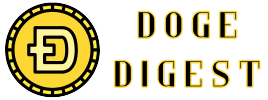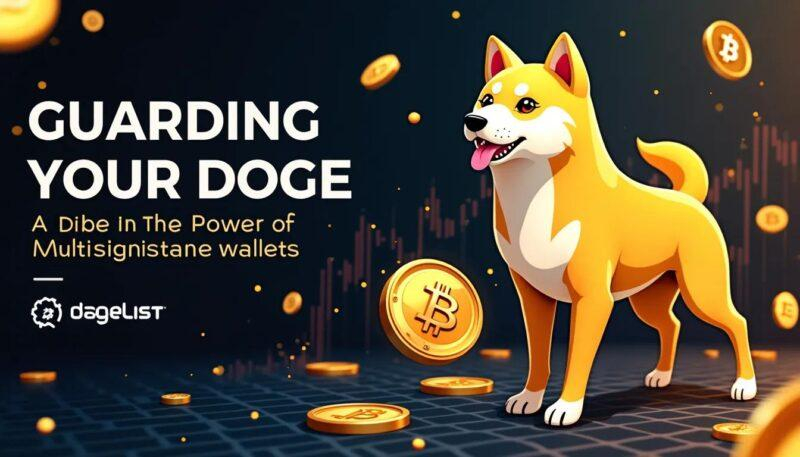In the vast and exhilarating world of cryptocurrency, Dogecoin has captured the hearts of many with its playful spirit and surprising staying power. But as the value of your digital assets grows, so does the need for robust security measures to protect them. Enter multisignature wallets-a powerful, yet often overlooked, tool that can transform how you safeguard your Doge. By requiring multiple approvals before any transaction can occur, multisig wallets offer a layer of protection that goes beyond simple passwords, ensuring that your beloved Dogecoin remains secure in an increasingly complex digital landscape. This article delves into the mechanics and benefits of multisignature wallets, helping you guard your Doge with confidence and control.
Understanding Multisignature Wallets and Their Security Benefits
At its core, a multisignature wallet enhances the traditional single-key approach by requiring multiple signatures before any transaction can be executed. This means that instead of relying on one private key, you need authorization from several parties – a simple yet powerful way to prevent unauthorized access. Imagine your Dogecoin secured not by a single lock but by a series of intricate safeguards, each keyholder acting as a guardian of your funds.
Why does this matter for security? Well, multisignature wallets reduce risks associated with stolen keys, lost passwords, or compromised devices. Even if one key falls into the wrong hands, the thief can’t move your Dogecoins without the other necessary approvals. This mechanism provides a decentralized trust model, making it ideal for shared wallets, corporate funds, or anyone looking for an extra layer of protection.
- Distributes control among multiple participants
- Mitigates single points of failure
- Offers customizable approval thresholds (e.g., 2-of-3 signatures needed)
| Multisignature Setup | Security Advantage | Typical Use Case |
|---|---|---|
| 2-of-3 | Balances security & convenience | Small team wallets |
| 3-of-5 | High protection against losses | Corporate treasury management |
| 1-of-2 | Backup key for emergencies | Individual with trusted contact |
How Multisignature Technology Shields Your Dogecoin from Theft
Harnessing multisignature technology transforms how your Dogecoin holdings are secured by requiring multiple approvals before any transaction goes through. Instead of relying on a single private key, this method distributes control across several keys – a safeguard that dramatically reduces the risk of theft from hacks, phishing, or key loss. Imagine each key as a distinct checkpoint; the more checkpoints you set, the harder it becomes for unauthorized users to bypass your wallet’s defenses.
At its core, this system is simple yet powerful. For example, a 2-of-3 multisig wallet might require approval from two different devices or individuals to authorize spending Dogecoin. This setup enables both flexibility and high security without sacrificing accessibility. You can customize multisig configurations to match your risk tolerance, whether it’s just yourself and a secure device or a trusted mix of family and friends. Key benefits include:
- Protection against a single point of failure: Losing one key won’t compromise your funds.
- Resilience to hacking attempts: Multiple signatures mean hackers need to breach several devices.
- Shared responsibility: Ideal for teams, businesses, or partnerships managing Dogecoin collectively.
To clarify how multisignature compares to traditional wallets, consider this quick overview:
| Feature | Standard Wallet | Multisignature Wallet |
|---|---|---|
| Number of private keys required | 1 | Multiple (e.g., 2-of-3) |
| Risk of single key compromise | High | Low |
| Ideal users | Individual holders | Groups, high-security users |
| Recovery options | Depends on backup of one key | Can recover with subset of keys |
Step-by-Step Guide to Setting Up a Multisignature Wallet for Dogecoin
Begin by selecting a reliable multisignature wallet provider compatible with Dogecoin. Popular options often support customizable signature thresholds-allowing you to decide how many co-signers are required for transactions. After installation, create your wallet and set the number of participants alongside the minimum number of signatures needed to authorize spending. This step is crucial, as it balances security with transaction flexibility.
Next, share the wallet’s multisig address with your trusted co-signers. Each participant will generate their own unique key pair, which must be securely stored. This collaboration ensures that no single party can move funds unilaterally, greatly reducing risks of hacks or mismanagement. Always encourage your co-signers to maintain backups of their individual keys – without them, unlocking the wallet is impossible.
Here’s a quick checklist to keep handy during setup:
- Choose a multisig wallet verified for Dogecoin
- Set the number of total & minimum signatures
- Distribute key pairs to each authorized signer
- Confirm all participants store keys securely
- Test a small transaction before moving larger amounts
| Step | Action | Tip |
|---|---|---|
| 1 | Download and install wallet | Pick open-source options for transparency |
| 2 | Configure multisig parameters | Set a threshold to balance security & usability |
| 3 | Share keys with co-signers | Use encrypted communication channels |
| 4 | Backup all keys safely | Use hardware wallets or secure offline storage |
Best Practices for Managing and Sharing Multisignature Wallet Keys
When it comes to safeguarding your multisignature wallet keys, the golden rule is decentralization. Instead of hoarding all keys in one place, distribute them among trusted parties or secure physical locations. This approach minimizes risks related to theft, loss, or even accidental deletion. Remember, the resilience of a multisig wallet depends on several keys being stored independently yet remaining accessible when needed. Avoid digital-only solutions; consider combining hardware wallets, encrypted USB drives, and even traditional offline methods like safes or safety deposit boxes.
Effective sharing of multisignature wallet keys demands clear communication and defined protocols. All co-signers or key holders should agree beforehand on usage rules-including thresholds for transaction approvals-or emergency procedures if a key is compromised. Transparency combined with discretion is key: maintain written records of who holds which key, but never store keys or passphrases unencrypted via email or cloud services. Instead, opt for secure messaging apps with end-to-end encryption or face-to-face key exchanges.
To bring it all together, here’s a simple matrix of responsibilities to assign among your multisig team, enabling smooth coordination without compromising security:
| Role | Key Storage Method | Security Tip |
|---|---|---|
| Primary Custodian | Hardware Wallet in Safe | Update firmware regularly |
| Backup Holder | Encrypted USB Drive Offline | Use strong passphrases |
| Emergency Delegate | Paper Backup Locked Away | Rotate location periodically |
- Regularly test recovery plans to avoid surprises during urgent access.
- Limit information sharing-only share essential details with trusted parties.
- Update key holders if changes occur in personnel or access protocols.
Evaluating Multisignature Wallet Providers for Reliability and Ease of Use
Choosing the right multisignature wallet provider demands a careful balance between security features and user experience. The best providers offer intuitive interfaces that demystify complex cryptographic processes while maintaining rigorous protection protocols. Look out for wallets that clearly state their key management policies and provide transparent recovery methods – these elements form the backbone of trustworthiness.
Reliability isn’t just about uptime; it encompasses the provider’s approach to backups, software updates, and community reputation. Platforms that employ decentralized backup solutions or integrate with hardware wallets elevate the security level without burdening users with excessive complexity. Meanwhile, ease of use is often enhanced through streamlined approval flows and clear, actionable prompts – ideal for both novices and seasoned crypto enthusiasts.
Below is a concise comparison of popular multisig wallet providers, highlighting the core factors to consider when securing your Doge holdings:
| Provider | Security Features | User Experience | Recovery Options |
|---|---|---|---|
| SafeSign | Multi-device authentication, biometric support | Clean UI, mobile-friendly | Seed phrase & cloud backup |
| GuardianX | Hardware wallet integration, multi-layer encryption | Step-by-step wizard, notifications | Social recovery & multisig quorum |
| TrustVault | Threshold signatures, cold storage | Minimalist design, fast setup | Encrypted USB storage |
When evaluating providers, prioritize features that align with your operational needs and technical comfort. A wallet that feels transparent in its processes and offers multiple layers of security can make all the difference in preserving your Doge’s legacy.
Q&A
Q&A: Guarding Your Doge – The Power of Multisignature Wallets
Q1: What exactly is a multisignature wallet, and why should Doge holders care?
A multisignature (or multisig) wallet is a cryptocurrency wallet that requires multiple private keys to authorize a transaction, rather than a single signature. For Doge enthusiasts, this means stronger security by distributing control among multiple trusted parties or devices. Instead of relying on one key-which could be lost, stolen, or compromised-multisigs provide a collective gatekeeper approach to your Dogecoin stash.
Q2: How does a multisignature wallet differ from a regular Dogecoin wallet?
A regular Dogecoin wallet uses one private key to manage and move your coins. If that key is compromised, your funds could be at risk. In contrast, a multisignature wallet requires multiple keys (for example, 2 out of 3) to approve any Doge transaction. This adds a robust layer of protection since no single keyholder can unilaterally spend the coins.
Q3: Can you give an example scenario where a multisig wallet would save the day?
Imagine you lose your phone that contains your Dogecoin private key. With a traditional wallet, that might mean losing access forever. But in a multisig setup, you might have one key on your phone, another on your hardware wallet, and a third with a trusted friend or family member. Losing one key doesn’t lock you out – the remaining keys can still sign transactions, preserving access and control.
Q4: Are multisignature wallets complicated to use for everyday Doge fans?
While multisig wallets introduce additional steps, many modern wallet providers offer user-friendly interfaces that simplify the experience. Setting up might require a bit more care and coordination, especially if keys are spread among different parties, but once established, sending Doge with multisig is straightforward. It’s a small tradeoff for a massive boost in security.
Q5: How does multisignature technology help with theft prevention?
Since a multisig wallet needs multiple approvals, a hacker who steals one private key can’t move your Dogecoin without the other keys. This drastically reduces the risk of theft, as an attacker would need to compromise several independent keys-often stored in different locations or devices-to gain access to your funds.
Q6: Can multisignature wallets be used for shared Doge ownership?
Absolutely. Multisig wallets are ideal for joint accounts, business partnerships, or community funds where multiple people should have control. For example, a 3-of-5 multisig wallet means five keyholders exist, but only three must agree to sign a transaction, ensuring democratic control over the Dogecoin.
Q7: Are there any downsides to using multisignature wallets?
Multisig wallets require coordination between keyholders, which can slow down transactions if keys aren’t readily accessible. Losing too many keys can lock everyone out, so secure key management is crucial. Also, not all Dogecoin wallets support multisig functionality yet, so choosing the right platform is important.
Q8: How can I set up a multisignature wallet for my Doge?
Start by selecting a wallet service that supports Dogecoin multisig features. Then decide on the number of keys and approval threshold (e.g., 2-of-3). Generate keys securely and distribute them among trusted parties or devices. Finally, configure the wallet and test it with small transactions to ensure everything works smoothly.
Q9: Is using multisig overkill for small Dogecoin holdings?
It depends on your comfort level with risk. For casual holders with minimal amounts, a single signature wallet with good security practices might suffice. But if you’re serious about safeguarding your Dogecoin, especially larger amounts, multisig wallets provide an excellent safety net that can save you from loss or theft.
Q10: What’s the future outlook for multisignature wallets in the Dogecoin ecosystem?
As Dogecoin continues to mature and grows in popularity, security solutions like multisig wallets will likely become more commonplace and easier to use. Developers are also exploring smart contracts and decentralized custody solutions that build on multisig principles, which could make managing Doge safer, more flexible, and accessible for everyone.
Multisignature wallets empower Dogecoin holders to protect their assets with a collaborative security approach-because guarding your Doge is more than just having a key, it’s having the right keys working together.
To Wrap It Up
As the digital frontier continues to expand, so too does the necessity for robust security measures that keep your prized Doge safe from prying eyes. Multisignature wallets stand as a testament to how innovation can empower users, blending simplicity with sophisticated protection. By requiring multiple approvals before a transaction can proceed, these wallets not only deter unauthorized access but also foster a shared responsibility over your crypto assets. In embracing multisig technology, you’re not just guarding your Doge-you’re investing in peace of mind amid the sprawling landscape of blockchain security. Ultimately, safeguarding your digital treasures is less about complexity and more about smart, thoughtful choices-and multisignature wallets deliver both in equal measure.






